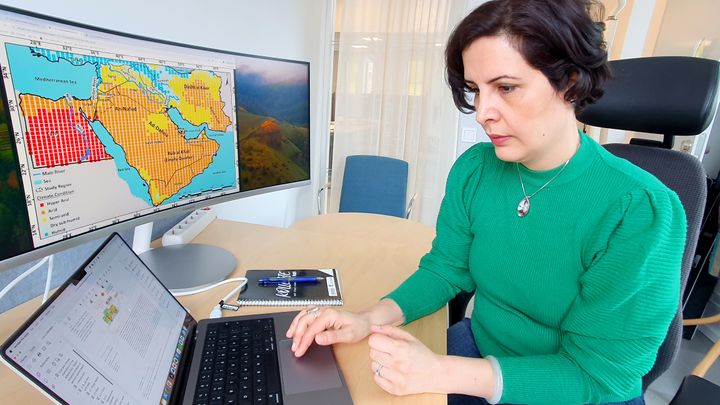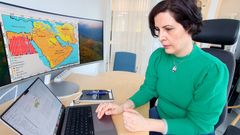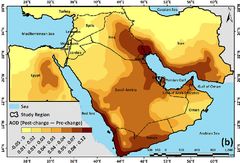Climate is one culprit in spread and growth of Middle East dust levels
Climate change is transforming dust storms—a natural phenomenon in the Middle East—into a more frequent and widespread threat to health and economies throughout the region, a new study shows.

Dust levels have increased in many parts of the Middle East chiefly due to global warming, but other human activities also share credit, says Zahra Kalantari, associate professor at KTH Royal Institute of Technology in Stockholm. She cites such factors as oil extraction, military conflicts and lack of cross-border coordination of water management.
Published in the journal Science of the Total Environment, the study maps the spread of aerosolized dust, and pinpoints where and when trends in precipitation and evaporation have changed course for the worse.
Analyzing multiple sets of data over the last 40 years, the researchers found an increase in dust levels in Saudi Arabia, Iraq, Yemen, parts of Iran and Egypt and countries around the Persian Gulf, while it has declined in northern Iran and southwest Turkey.
Sharp increase in last 20 years
The area between the Tigris and Euphrates rivers in northern Iraq and along the Syria-Iraq border was reported to have the highest concentration of dust sources in the region, reflecting a sharp increase over the last 20 years.
The researchers documented a notable decrease in precipitation in northern Iraq, Syria, southwestern Iran, and southern Turkey. The natural effects of the area’s arid and hot climate have also been intensified by factors such as deforestation, dam building, over-irrigation and extraction of water and military conflict. Kalantari says one serious result is the reduction of soil moisture and vegetation coverage, which normally help reduce dust levels.
The environmental consequences include soil erosion, biodiversity loss and desertification, she says. Economic losses may result from damaged infrastructure, disrupted agriculture and reduced tourism.
Social disruption also can be expected, she says, and vulnerable populations will suffer disproportionately.
Kalantari says regional cooperation is vital to address complex factors and implement effective dust control measures. Comprehensive strategies are imperative to mitigate adverse effects on health, ecology, and socio-economic development.
The researchers call for “a comprehensive strategy focusing on environmental management and policy reforms.” Prescriptive measures include: reforestation, soil conservation, water conservation, regional cooperation, sustainable urban planning, advanced monitoring systems, public awareness campaigns and climate adaptation measures.
“These efforts, combined with research and cross-border collaboration, are essential for a sustainable environment that is resilient to dust storms in the Middle East,” Kalantari says.
Images



Subscribe to releases from KTH Royal Institute of Technology
Subscribe to all the latest releases from KTH Royal Institute of Technology by registering your e-mail address below. You can unsubscribe at any time.
Latest releases from KTH Royal Institute of Technology
For graphene production, a potential green alternative to mining graphite3.3.2025 14:14:40 CET | Press Release
Researchers in Sweden report a green alternative to reduce reliance on mining graphite, the raw source behind the "wonder material" graphene.
AI on aircraft can help prevent stalls and terrifying drops in altitude17.2.2025 15:58:14 CET | Press Release
Artificial intelligence could help prevent terrifying mid-air drops in altitude. In a new study, an international research team successfully tested a machine learning system for preventing trouble with turbulence.
Alternative to studded winter tires reduces airborne particles by 20 percent6.2.2025 14:41:07 CET | Press Release
On icy roads, studded winter tires can save lives – but they pulverize pavement and fill the air with dangerous, inhalable particles. A new Swedish study shows that both road wear and airborne particles could be reduced by as much as 20 percent if studs were made instead with an alternative hard metal.
As Scandinavian peninsula rises from sea, new satellite data shows gravity changes6.2.2025 09:15:25 CET | Press Release
Bouncing back from under the weight of Ice Age glaciers which have long since vanished, the Nordic region land mass is slowly rising above sea level. Two scientists at Sweden’s KTH Royal Institute of Technology have a refined a method for measuring and predicting the small details of how this slow movement changes Earth’s gravitational pull over time. One thing they found is that the Fennoscandinavian peninsula's land mass is more dense than previously known.
Study on ship sliming may enable reduced costs and emissions in ocean transport21.1.2025 11:25:01 CET | Press Release
Slime build-up is a costly drag on fuel efficiency for ocean-going cargo ships, leading to more emissions and, eventually, higher consumer prices. A recent study, however, suggests a new approach to managing this common problem.
In our pressroom you can read all our latest releases, find our press contacts, images, documents and other relevant information about us.
Visit our pressroom